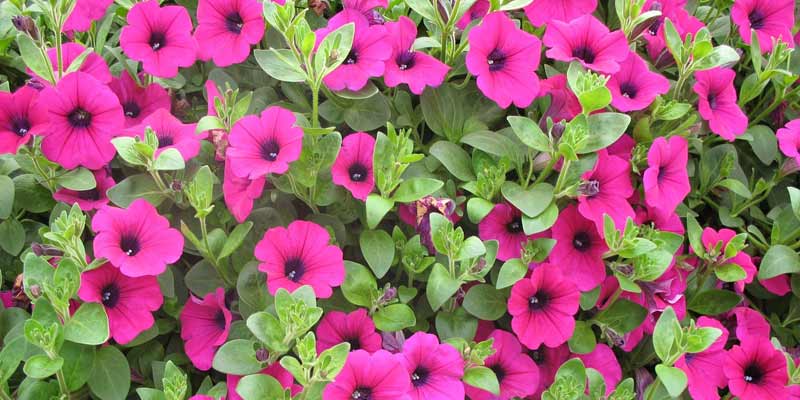With their vibrant colors and cheerful blooms, petunias often grace gardens, containers, and hanging baskets; they can thrive on a sunny patio or add splashes of color to flower beds. To guarantee optimal growth and prolific flowering, a spectacle indeed!
One must understand the sunlight requirements of petunias. This article delves into the sunlight requirements of petunias: it explores not only the importance of sunlight- a vital factor influencing their growth and bloom abundance, but also strategies for providing ideal lighting conditions.
The Importance of Sunlight for Petunias
Sunlight is crucial for the growth and development of petunias, serving several essential functions:
1. Photosynthesis: All green plants, including petunias, rely on sunlight to execute photosynthesis; this is the process through which they transform light energy into chemical energy – a fuel for their growth and metabolism.
2. Flower Production: Adequate sunlight is the key stimulator of petunias’ flower bud formation and blooming process; it promotes their overall aesthetic appeal. Conversely, insufficient light levels, if not carefully monitored could induce sparse flowering in these plants while also reducing flower size – a compromise to their visual allure.
3. Color Intensity: Sunlight enhances the intensity and vibrancy of petunia flower colors: it amplifies their visual impact, and increases their attractiveness to pollinators – a direct influence on color intensity.
Sunlight Requirements of Petunias
Sun-loving plants, petunias in particular, thrive under full sunlight and require a minimum of 6-8 hours of direct exposure per day for optimal growth and flowering.
Even though they may benefit from some protection during intense midday sun in regions with hot summers – especially amidst periods of extreme heat – generally speaking; petunias perform their best when bathed generously by ample sunlight throughout the entirety of each day.
4 Factors Influencing Sun Exposure
Several factors influence the amount of sunlight petunias receive, including:
1. Location: Location significantly determines the sun exposure of petunia plantings: planting petunias in open, sunny areas guarantees maximum daily sunlight–this promotes vigorous growth and prolific flowering.
2. Seasonal Variations: The fluctuation of sunlight levels throughout the year results from seasonal changes in daylight hours and the sun’s angle. Typically, during summer’s long days when daylight hours reach their maximum, petunias bloom at their peak.
3. Shade from Surrounding Structures: Buildings, trees, and other structures may cast shadows that affect the sunlight reaching petunia plants; therefore, it is best to plant petunias away from tall structures and obstructions. This strategy minimizes shading and maximizes their exposure to sunlight.
4. Container Size and Placement: Compared to their counterparts planted directly in the ground, petunias that grow in containers might suffer from limited sunlight exposure. Select containers featuring ample drainage holes; position these adequately equipped vessels in sunny locales – thereby ensuring an unobstructed path for proper root-to-sunlight penetration of your plants.
5 Strategies for Providing Adequate Sunlight
Consider implementing the following strategies to guarantee optimal growth and flowering of your petunias:
1. Selecting Planting Sites
Choose planting sites that bask in full sun for most of the day; ideally, these locations should also catch morning sunlight and offer a hint of partial shade in the afternoon. Such conditions will shield your plants from harsh midday heat – an essential protective measure.
2. Pruning and Thinning
The surrounding foliage requires pruning, while the overcrowded plantings need thinning out to permit sunlight penetration. This will enable it to reach lower foliage and flower buds.
3. Placement of Containers
Place your petunia containers in sunny spots – patios, balconies, or windowsills; this ensures they receive optimal sunlight throughout the day.
4. Rotate Containers
Periodically rotate the containers when you grow petunias in them; this action ensures balanced growth and flowering by allowing all sides of the plants to receive equal sunlight exposure.
5. Sunlight Level Monitoring
Regularly measure the sunlight levels in various garden areas using a sunlight meter or by discerning patterns of shade and light throughout each day; then, utilize this data, an indispensable tool for adjusting planting locations to enhance sun exposure optimization specifically for petunias and other plants that thrive under direct sunlight.
Signs of Inadequate Sunlight
It is crucial to recognize signs of inadequate sunlight to address potential issues and ensure the health and vitality of petunia plants. Some common indicators that point towards insufficient sunlight are:
Sparse Flowering
Petunias may exhibit sparse flowering, a condition characterized by reduced flower production and scarce blooms. This phenomenon suggests inadequate sunlight exposure: the lack of sufficient light does not stimulate petunia’s natural process for forming flower buds or initiating blooming.
Leggy Growth
Plants, in their effort to compensate for insufficient sunlight levels, typically display leggy growth: elongated stems and sparse foliage–symptoms commonly associated with inadequate light exposure.
Pale or Faded Flower Colors
Insufficient sunlight can cause petunia blooms to exhibit pale, faded colors; this diminishes their visual impact and vibrancy.
Conclusion
The growth, development, and flowering of petunias depend significantly on sunlight as a vital resource; it directly influences their health and vitality. To foster healthy—vibrant even—plants with abundant blooms: understand the sunlight requirements of petunias; and devise strategies for adequate sun exposure, these are indispensable factors.
Selecting sunny planting sites is crucial – coupled with vigilant monitoring of sunlight levels–and addressing any signs that indicate inadequate sunlight ensures not only thriving conditions but also delightful displays filled with color throughout the growing season from your flourishing petunia garden.
Petunias, with their radiant blooms and captivating colors, can flourish in gardens, containers, and landscapes when they receive proper sunlight and care; indeed–they add an undeniable beauty and charm.



Leave a Reply